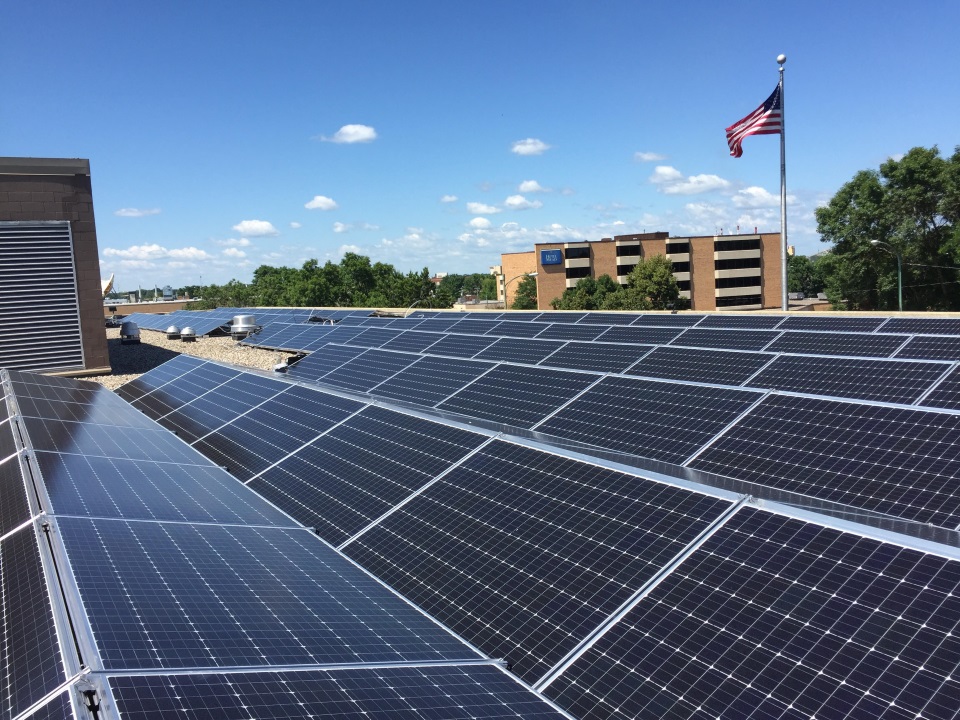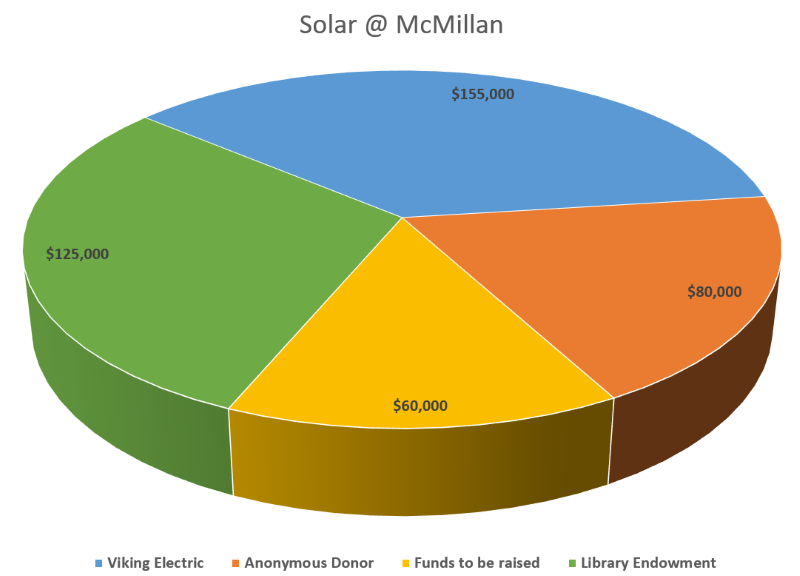
In the Summer of 2017, McMillan Memorial Library installed a rooftop solar array, but now needs community support to finalize its purchase.
The array moved the Library to a greener future, will save us money and provides green power to our community. Due to innovative financing, the $420,000 project is mostly paid for. Viking Electric, and its owner Scott Prahl, are funding much of the project and utilizing the associated tax credits. The Library Endowment also contributed funds for the project. The Library is relying on community support for the remainder of the costs. Fortunately, an as-yet anonymous donor has pledged to match all donations, so our goal is $60,000.
How can I support the project?
All donations are welcome and are tax deductible. Donations are accepted at any service desk or at the Business Office (715-422-5129). All donors of $10 or more will receive a certificate and acknowledgement on our donor board. Solar panel donors ($125) will receive a private tour of the solar array. Kilowatt ($500) and Megawatt ($1,000) will receive a framed certificate and a private tour. Donors can choose to remain anonymous or to forego tours and certificates. Organizations, classroom and families can pool their donations to earn a private tour or other recognition.
 How was the project funded?
How was the project funded?
No City operational or capital funding was used in this project, though some incidental expenses came from the Library's budget and both Library and City staff were involved in developing the project. The Library Endowment, which exists to undertake such special projects, put a down payment on the system. Viking Electric, who also served as contractor, paid the bulk of the costs and will own the array for the first six years. During that time, they will sell the power generated to the Library and utilize various tax credits. After that time, the Library will buy the project. While the Library Board was developing the project, a donor came forward and pledged to match all donations to the final purchase price. The Library's fundraising goal is $60,000.

How large is the system?
It is a 235kW array, with 470 panels. Each panel is rated at 500 watts. These are large utility grade panels, noticeably larger than most residential panels. The array covers 13,000 square feet of the Library's roof. It is projected to produce 200,000 kWh annually, enough for twenty average homes. This is one of the largest systems in Central Wisconsin and one of the largest on a public building in the state. Despite this, it does not fully meet the Library's annual energy needs and the production does not match use. We are open on cloudy days and at night, when production is low or non-existent. Alternatively, it will overproduce on sunny days and Sundays. The Library will both buy from and sell electricity to Water Works & Lighting, providing the community with locally produced green power. The Library is also working diligently to reduce its energy usage and to more closely match consumption with production.
Can we see the array?
The panels are not visible from the ground. A sample panel is mounted in the Library Commons. Panel level donors get a private tour. We are planning public tours in conjunction with local events, so watch our calendar.
How much power is it producing?
Production depends upon how sunny it is and how high the sun is. The array works better in cooler temperatures. For most of the year, the Library is "off the grid" for at least part of the day. Some days the array produces more then the Library used, though production and use are often mismatched. When we produce more than we can use internally, the overproduction is sold to WW&L for use in the community. About 1/3 of all power generated will be used in the community. You can track production live. When the air condition is not needed, our consumption usually runs under 60kWh on that graph.
What happens when it snows?
The snow melts or slides off the panels as soon as its sunny. Unless the snow is deep enough to bury the panels, they quickly clear themselves.
How about hail?
The panels are utility grade, with thick glass and aluminum backs. Only very severe impacts would damage them. If they were damaged in one section, the rest of the panel would continue to operate normally. In any case, the Library has a supply of replacement panels on hand.